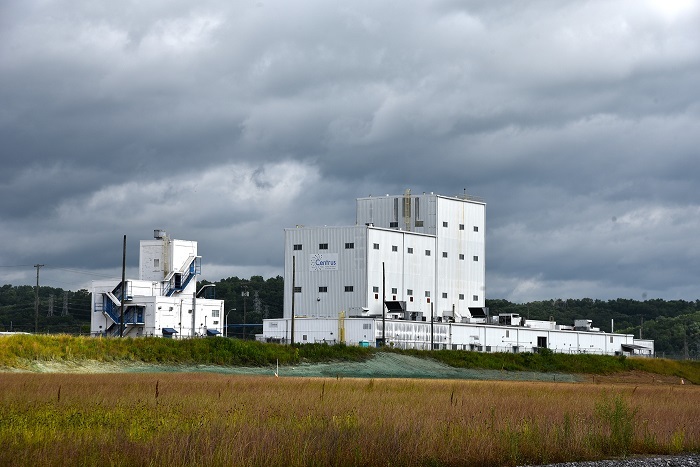 Crews have completed deactivation inside the 42,000-square-foot K-1600 facility. Teardown is scheduled to begin this summer. It will mark the final demolition project for the Oak Ridge Office of Environmental Management and its cleanup contractor UCOR to achieve Vision 2020.
OAK RIDGE, Tenn. – Workers have completed deactivating Building K-1600, a former test and demonstration facility for uranium enrichment centrifuges at the East Tennessee Technology Park (ETTP), and now it is ready for demolition.
“This is an incredibly significant project for us and our contractor UCOR because it paves the way for the final demolition at ETTP and positions us to accomplish our ambitious Vision 2020 goal,” said Jay Mullis, manager of the Oak Ridge Office of EM. Among EM’s 2020 priorities, Vision 2020 is the cleanup program’s goal to complete all demolitions and major cleanup at ETTP by the end of 2020. It will mark the first time in the world an enrichment complex is cleaned and removed. The 42,000-square-foot K-1600 facility was transferred to Oak Ridge cleanup contractor UCOR in September 2019 to complete deactivation and demolition. Centrus Energy Corp. had leased Building K-1600 since 2002 and finished decommissioning activities prior to the transfer. The company no longer needed the lease after consolidating its centrifuge testing and demonstration activities into a location in Oak Ridge.
Building K-1600 is a recognizable facility at ETTP due to its height and location. It sits in the center of the footprint for the former mile-long, U-shaped K-25 Building. K-25 was one of the site’s five massive gaseous diffusion buildings that once held the title of the world’s largest building.
Deactivation of K-1600 included rendering the building “cold and dark,” which means disconnecting utilities to the structure and installing temporary utilities, such as electrical power. It also included asbestos abatement and waste removal.
Demolition is scheduled to begin this summer.
To date, Oak Ridge’s EM program has taken down facilities spanning nearly 13 million square feet, transferred more than 1,200 acres of land for economic development, and placed more than 3,000 acres in a conservation easement for community recreational use.
Additionally, more than 100 acres will be used for historic preservation efforts at ETTP. Since the K-25 footprint is part of the Manhattan Project National Historical Park, the demolition of Building K-1600 will increase accessibility and remove risks in the area for future use. -Contributor: Wayne McKinney
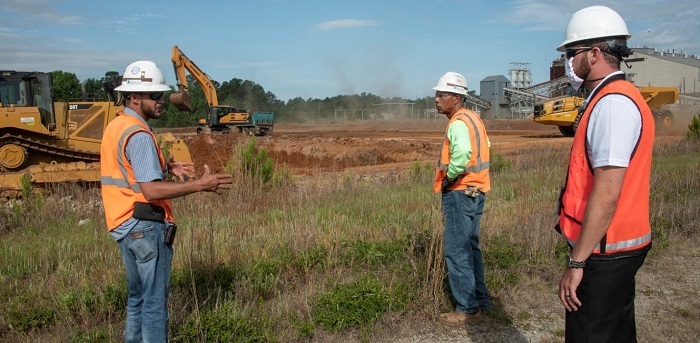 While maintaining social distancing, Savannah River Nuclear Solutions (SRNS) heavy equipment operators Tyler Wilson, left, and Ed Townsley, center, update SRNS Project Manager Kelsey Holcomb regarding the D-Area Coal Storage Yard Project at the Savannah River Site.
AIKEN, S.C. – The long metal arm and strong steel teeth of a massive construction excavator recently cleared its first bucket full of hardened clay containing countless bits and pieces of coal, the first step towards removing contaminated soil from 12 acres at the Savannah River Site (SRS) known as the D-Area Coal Storage Yard.
Until recently, the yard held huge piles of coal used to continuously feed an enormous powerhouse built in the late 1950s that provided steam and electricity for SRS missions. The site shut it down in 2012 and launched an innovative technology that burns forest debris, agricultural waste, and scrap lumber to generate steam and power. The powerhouse is now cold and dark, awaiting demolition.
“Any large pile of coal that sits for nearly six decades will interact with rainwater and the atmosphere,” said Kelsey Holcomb, a project manager with EM contractor Savannah River Nuclear Solutions (SRNS). “Coal contains iron sulfide, also known as pyrite or fool’s gold. And when it mixes with rainwater, it creates sulfuric acid. The acidity leaches into the soil and draws out heavy metals such as beryllium and chromium.”
According to Holcomb, these heavy metals are found primarily within the first few feet of soil but will slowly migrate over time into the groundwater where they might risk reaching the Savannah River, a source of drinking water for downstream communities.
“We like to catch things as far up stream as possible before we get into a human health or ecology threat condition,” Holcomb said. “We’re taking action to remedy the acidic condition of the soil in the coal storage yard. It currently has about the same pH as a cola-based soft drink, around 3.0 to 3.2. We’re going to thoroughly mix fine grade limestone throughout 12 acres of the coal storage yard down to four feet, which will bring the pH back to around 5.5. That’s normal for this area.”
Plans call for using approximately 1,000 tons of fine-grade limestone over six months to complete the project. The material was purchased from a quarry in eastern South Carolina.
SRNS construction personnel will work on only one acre at a time to control erosion and ensure no sediment enters nearby creeks and streams as a result of soil excavation. The construction workers will operate an excavator, dump trucks, a road scraper, and a large industrial mixer to treat each section of the coal yard.
Gigantic piles of unused coal were removed from the coal storage yard in 2012 and the surface was scraped to reveal a layer of red clay.
“It looks like the surface of Mars out there,” Holcomb said.
The sprawling coal storage yard will change from red to gray over the next six months as the final covering, normally sodded grass, will include a layer of limestone gravel. This innovative approach is expected to shorten the project schedule and significantly reduce the overall cost.
“Working closely with our South Carolina and federal environmental regulators, this project is typical of the creative, cost-effective, and responsible cleanup activities we as a company have embraced while successfully remediating dozens of projects since SRNS became the management-and-operations contractor in 2008,” said Chris Bergren, SRNS director of environmental compliance and area completion projects.
-Contributor: DT Townsend
IDAHO FALLS, Idaho – EM and cleanup contractor Fluor Idaho have finished processing a challenging liquid waste form dubbed “squeezants,” allowing the material to be sent from the Idaho National Laboratory (INL) Site to an out-of-state permanent disposal facility.
“This was a great effort on the part of our crews to safely treat this material and prepare it for shipment to the Waste Isolation Pilot Plant (WIPP) or other off-site facility for compliant disposal,” said Ross Langseth, Fluor Idaho operations manager at the INL Site’s Advanced Mixed Waste Treatment Project (AMWTP).
The radioactive and hazardous liquid wastes were generated by AMWTP’s supercompactor when 55-gallon waste drums were crushed with 4 million pounds of force to create what resemble 5-inch-thick hockey pucks to reduce their shipping and storage volume. Squeezants are the liquids that were "squeezed" out of the waste drums by the supercompactor. The squeezants captured in the supercompactor’s sump were later moved to 4-liter jars and placed into 55-gallon drums.
Those drums were transferred to six drum overpacks and brought into one of the facility’s boxlines where the squeezants were soaked up by an absorbent and blended with debris waste. The material was then put in 55-gallon drums and compacted in the supercompactor. Boxlines are huge concrete and metal hot cells where containers of radioactive waste are opened and sorted without exposing workers to the materials inside.
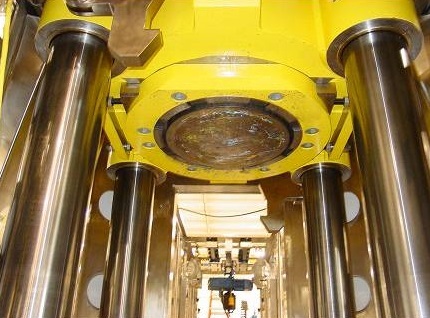 |
|
The supercompactor ram at the Advanced Mixed Waste Treatment Project exerts 4 million pounds of force to compact filled waste drums. |
Since 2003, workers at AMWTP have retrieved, treated, packaged, certified, and shipped an inventory of 65,000 cubic meters of transuranic and low-level wastes generated during nuclear weapons production at the former Rocky Flats Plant and other Cold War facilities. The waste was shipped to the INL Site for above-ground storage from 1970 to the late 1980s. AMWTP completed treatment of transuranic debris waste in October 2019 and is scheduled to continue sending that waste to WIPP throughout the next decade.
“Our crews are some of the best in the business when it comes to dispositioning challenging wastes,” Langseth said. “We prove each and every time that it can be done safely.”
-Contributor: Erik Simpson
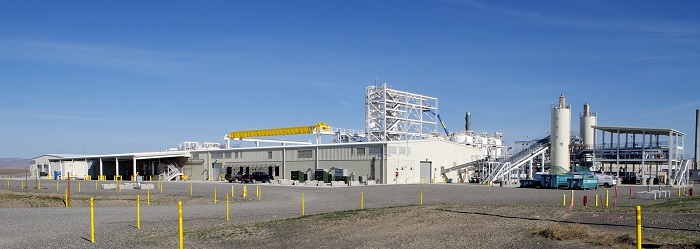 The 200 West Pump and Treat Facility is Hanford’s largest groundwater treatment plant. All six of Hanford’s operating pump-and-treat facilities can be monitored remotely, allowing plant managers to ensure the systems continue to operate safely and efficiently while meeting social distancing requirements. The six facilities combined have treated more than 1.6 billion gallons of contaminated groundwater in fiscal 2020, which began Oct. 1.
RICHLAND, Wash. – Despite the challenges posed by the COVID-19 pandemic this spring, Hanford Site groundwater treatment continued largely uninterrupted and remains on track to meet EM’s goal of treating at least 2.2 billion gallons of contaminated groundwater in fiscal 2020.
Hanford’s advanced pump-and-treat systems allow operations managers with EM Richland Operations Office (RL) contractor CH2M HILL Plateau Remediation Company (CHPRC) to safely monitor the facilities remotely from home — meeting social distancing requirements while ensuring the plants continue to operate efficiently during the site’s essential mission-critical operations posture.
“The efficiency and reliability of Hanford’s treatment systems have been instrumental to our ability to maintain this key component of our cleanup mission that’s so critical to the protection of the Columbia River,” said Mike Cline, RL project director for cleanup of soil and groundwater at Hanford.
Hanford’s six operating pump-and-treat facilities have collectively treated more than 1.6 billion gallons of groundwater in fiscal 2020, which began Oct. 1. In the first quarter of fiscal 2020, the 200 West Pump and Treat Facility alone treated more than 300 million gallons of contaminated groundwater on Hanford’s Central Plateau, a record volume for any quarter since the site’s largest treatment plant began operating in 2012.
“I’m proud of our team’s efforts to stay focused and ensure our facilities operate safely as we continue striving to meet our cleanup goals,” said Bill Barrett, vice president of CHPRC’s soil and groundwater remediation project. “The ability to maintain safe operations during these unique times has truly been a team effort and the result of excellent communication and collaboration between our workers, labor, DOE, and the regulators.”
Through the life of the cleanup mission, Hanford has treated more than 23 billion gallons of groundwater and removed more than 500 tons of contaminants, including the majority of the chromium along the River Corridor and hundreds of tons of nitrates on the Central Plateau, as well as other contaminants of concern such as carbon tetrachloride, uranium, and technetium-99.
-Contributor: Dieter Bohrmann
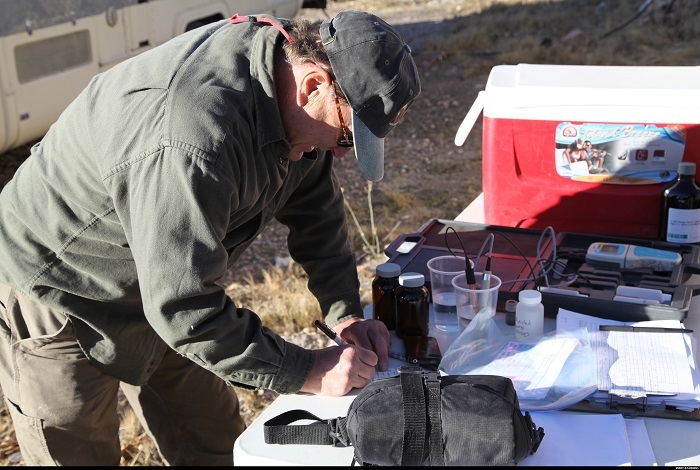 Nye County’s John Klenke collects water samples from an Amargosa Valley location.
LAS VEGAS – The EM Nevada Program has awarded a two-year grant extension to an intergovernmental groundwater testing program carried out by Nye County that works to ensure the safety of publicly accessible water.
The Tritium Sampling and Monitoring Program, an EM grant-funded initiative, supports annual independent sampling for tritium at locations near the Nevada National Security Site (NNSS). Tritium is the primary contaminant of concern, because it is highly mobile in groundwater and can serve as an indicator of contaminant migration from nuclear testing.
“We are proud of our collaborative partnership with Nye County, which is helping to ensure the continued safety of publicly accessible water near the Nevada National Security Site,” said Rob Boehlecke, EM Nevada Program manager. “The Tritium Sampling and Monitoring Program is a valuable initiative that continues to show no detectible migration of tritium at sampling locations in Nye County."
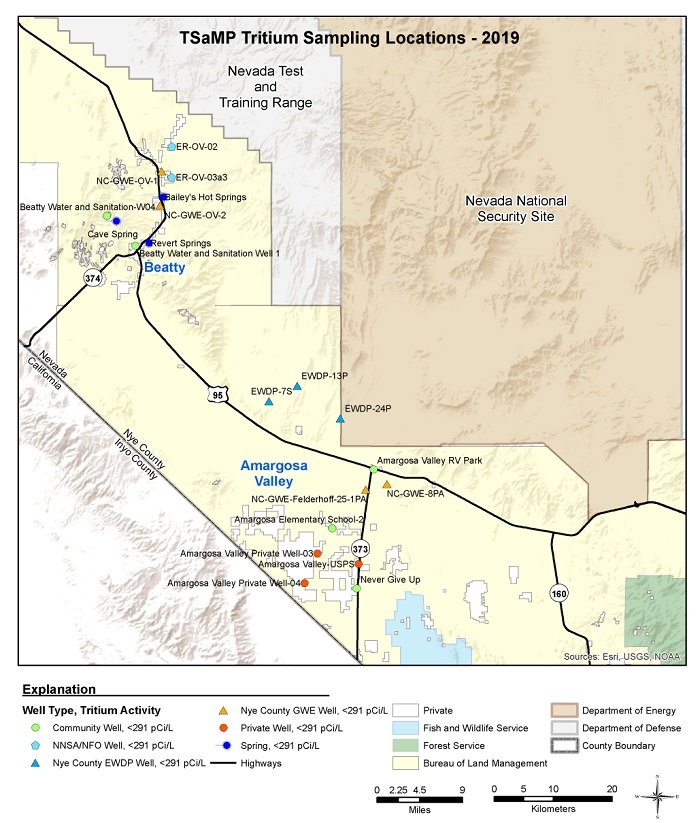 Private wells, natural springs, and local facilities make up the 20 tritium sampling and monitoring locations the Tritium Sampling and Monitoring Program sampled in 2019. For more information, visit the Nye County Nuclear Waste Repository Project.
The collaborative sampling and monitoring initiative was initiated in 2015 when EM issued a five-year, $1.27 million grant to Nye County to monitor tritium in wells near the NNSS. The grant also supports the county’s involvement in technical reviews of the historical nuclear underground test area groundwater activities.
Geoscientists under the Nye County Nuclear Waste Repository Project Office have sampled and monitored 50 separate locations since the program began, including 42 wells and eight springs. Of these sites, 10 are sampled every year, while the other 10 locations rotate annually. The 2019 sampling results of 17 wells and three springs found no detectible levels of tritium in the sampled locations.
As the environmental program services contractor for the EM Nevada Program, Navarro Research and Engineering has supported Nye County in coordinating the administration of the Tritium Sampling and Monitoring Program. Other supporting partners include the State of Nevada Division of Environmental Protection, Desert Research Institute, and the Nevada Site Specific Advisory Board.
-Contributor: Michelle French
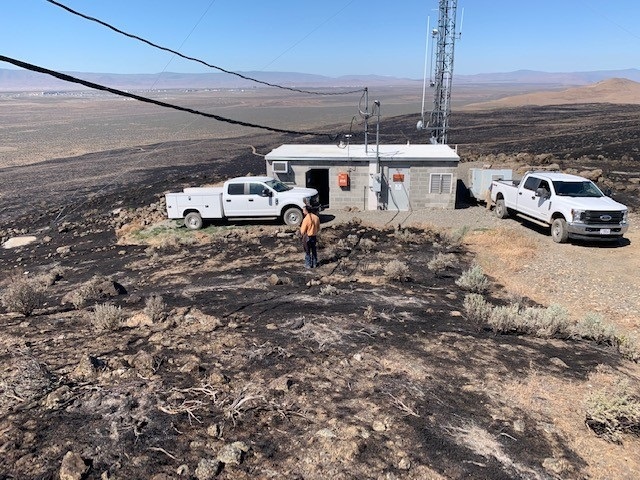 Kenny Ferguson, director of information technology infrastructure services for Richland Operations Office, inspects for potential damage to an unoccupied facility following the Gable Mountain fire, which burned more than 5,000 acres on the Hanford Site.
RICHLAND, Wash. – In a well-coordinated effort, the Hanford Fire Department and nearby cities and counties successfully contained a wildfire that presented firefighters with many challenges and obstacles.
Lightning sparked the fire that burned more than 5,000 acres of Gable Mountain, located near the center of Hanford, earlier this month. No one was injured.
“Before the fire was contained, I had the opportunity to visit the fire command center and see firsthand the hard work and dedication of the Hanford Fire Department and other firefighters from neighboring cities and counties,” said Brian Vance, Hanford Site manager. “These men and women were battling challenging conditions to ensure the safety of our people, the site, and our community.”
The fire department, managed by Hanford contractor Mission Support Alliance (MSA), called in firefighters from the nearby cities of Richland and Kennewick, as well as Walla Walla, Benton, and Franklin counties to combat the wildland fire. MSA also used heavy equipment operations to support firefighting efforts.
“Firefighting crews were challenged with heavy fuels due to the location, difficult-to-access locations, and changing weather conditions such as strong winds and increasing temperatures,” said Adam Moldovan, acting fire chief of the Hanford Fire Department.
Lightning also caused several other small fires across the 580-square-mile site. Firefighters quickly extinguished those fires, protecting facilities and allowing them to return focus to the Gable Mountain effort.
-Contributor: Melissa VerSteeg
|